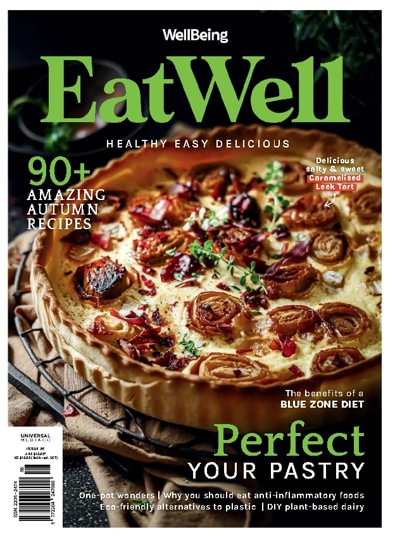Eat Well digital subscription
Current Issue: Issue 56
Single Issue
Price: $3.30
you save up to 33%
Earn up to 70 isubscribe Rewards Points, that's 5 points per $1 spent.
This is a digital subscription supplied by Zinio, who will deliver the digital editions direct to your inbox - you can access them directly through your web browser or download the Zinio app on your mobile device. Which devices can I read on?
A sexy Recipe Mag that has a healthy approach to good food
A sexy Recipe Mag that has a healthy approach to good food. Taste every page as you flick through – delicious! Why bother? Because everything in here is good for you, easy, and yum. We know you are busy so we give you everything you need to eat well – recipes, shopping lists, quick ideas. You’re tapping in to a heap of wisdom from passionate chefs, bloggers and caring home cooks. You can share yours too – we’re a community. Life’s short…. outsource your food plan to people who love healthy good food. If you stopped buying recipe mags years ago because they’re full of things you can’t eat – then try Eat Well! Over 70 recipes per edition.
Be the first!
& get $5 off your next purchase
Be the first person to tell us what you think about Eat Well and you'll save $5 on your next purchase!
In This Issue:
Finger lime
Finger lime, often called “citrus caviar”, is a fascinating fruit native to the rainforests of eastern Australia. Shaped like a small cucumber, this unusual lime bursts with tiny, caviar-like beads known as “vesicles”, which separate from the pulp. Each bead holds a tart, lime-flavoured juice that delivers a bright citrus kick, making finger lime a sought-after delicacy in fine dining and gourmet cooking.
The fruit comes in a variety of colours, from pale green and yellow to vibrant pink and ruby red. When sliced open, the beads can be gently squeezed or scooped out, retaining their shape and offering a unique burst of flavour and texture. Because of this, finger lime is commonly used as a garnish for seafood, cocktails and desserts, where it brings a fresh, zesty element and…
Kohlrabi
Kohlrabi, sometimes known as the “German turnip”, is a crisp, bulbous vegetable in the brassica family, closely related to cabbage, broccoli and cauliflower. Its unique appearance — with leafy stems sprouting from a round, pale green or purple bulb — makes it stand out, while its mild, slightly sweet taste has earned it a loyal following in culinary circles.
The flavour of kohlrabi combines hints of cabbage and broccoli, with a texture that's similar to a radish or an apple when raw, making it perfect for adding crunch to salads and slaws. The vegetable can be enjoyed both raw and cooked, thinly sliced in salads, cut into sticks for snacking or roasted, mashed or stir-fried for a more mellow flavour. Even the leaves are edible and can be prepared like…
from the EDITOR
Hello, it's me again! I'm here for a little cameo appearance for one issue, right before I go on maternity leave. I'm also here to share some great news … the talented Dana Diament will be taking the reins of EatWell — and trust me, you're in good hands. She's a huge food lover (I've tasted her cooking!) and has always dreamed of creating a cookbook. The lovely Cat, who you heard from in the last two issues, filled in for a few editions while we took pause, reimagined EatWell and prepared to bring you something bigger, better and brighter.
In this issue, you'll learn how to grow Brussels sprouts, grapes, capers and mandarins in our new section, Garden to Table. You asked for more garden and growing tips, so…
Watercress (Nasturtium officinalis)
This interesting plant is a brassica, so is related to mustard and cabbage. Watercress is a leafy aquatic plant that's found its way onto our tables in watercress sandwiches, in fancy salads and as a garnish. It is also a delicious sprout. Watercress is nutritious but has a very short shelf-life: two good reasons to grow your own.
A recent study from the US Center for Disease Control named it as the most nutritious vegetable to eat. Analysis shows it is a good source of iron, is rich in folic acid and also contains high amounts of calcium, protein, fibre and vitamins. One of its constituents — gluconasturtiin — may even inhibit carcinogens.
This is a plant of many faces — I've seen it growing in streams and creeks in…
Betel leaf (Piper sarmentosum)
The heart-shaped, glossy, dark-green leaves of betel leaf are used to make a delicious snack (miang kham) topped with (or wrapping) a fragrant mix of minced prawn, lime, chopped peanuts, herbs and spices in a tangy sauce. The leaves have a nice chewy texture and a mildly peppery, spicy flavour.
While these leaves make perfect finger food or starters for a Thaistyle meal, other South-East Asian cuisines also use them shredded in salads, omelettes and stir-fries to add their peppery flavour to the dish. In fact, among betel leaf's common names are wild pepper, vegetable pepper and betel pepper as well as wild betel.
This plant is not only valued for its culinary uses, however. In many Asian countries its leaves and roots have been traditionally used for a number…
Sawtooth coriander (Eryngium foetidum)
Growing annual coriander (Coriander sativum) can leave gardeners frustrated and craving the taste of its leaves. Coriander has a habit of bolting to seed when it comes under the slightest stress, such as too much heat, humidity or a lack of water. As it begins to flower and set seed, the leaves become strongly flavoured and unpleasant to eat.
When this happens, you can give up and simply harvest coriander seed, which is a popular spice, or you can try growing another plant altogether. Sawtooth or perennial coriander is a thistle-like biennial with coriander-flavoured leaves. It doesn't look like coriander but is part of the same family, the Apiaceae or the carrot family. Like normal coriander, it's easily grown from seed but, unlike its namesake, is not prone to bolting.…
A GUILTY treasure
When Robert Falcon Scott and his crew set off for the South Pole, two of the precious foods that they chose to carry with them were malted cocoa powders and milk chocolate bars. If you are facing temperatures of -22°C, searing winds and intense physical exertion, chocolate offers not only nutrition and calories but also comfort. Of course, even if you aren't racing a bunch of Norwegians across the Antarctic, chocolate has a lot to recommend it. Chocolate is not just a food, it is an event, an expectation, a gift, a solace, a celebration and a companion. You will have turned to chocolate at some time, maybe even today, possibly as you read this. We all have. The question is whether you need to relax about enjoying your chocolate…
BLUE ZONES
Blue Zone Harvest Bowl
Recipe / Naomi Sherman
There are a few basic guides to eating a Blue Zone-inspired diet: plants are king, reduce sugar wherever possible, incorporate beans into your daily diet and eat seasonally as a priority.
Serves: 4
1kg firm vegetables such as potato, sweet potato, pumpkin, carrot, red onion 500g softer vegetables such as eggplant, zucchini, broccoli ¼ cup olive oil Salt & pepper, to taste 1 tbsp finely chopped fresh rosemary 1 tin butter beans, rinsed & drained
Tahini Dressing
¼ cup tahini ¼ cup Dijon mustard 2 tbsp apple-cider vinegar 1 tbsp maple syrup 1 tbsp lemon juice ¼ cup water Salt & pepper, to taste
1. Preheat oven to 200°C.
2. Cut your vegetables into similar-sized small pieces, keeping the firm and soft…
The very best dairy
Brancourts has been crafting dairy goods in Australia for more than 125 years. Its range of Classic, Protein+, Lactose Free and 97% Fat Free Cottage Cheese is available nationally through major supermarkets. We know you will enjoy their simple dairy goodness for breakfast, lunch, snacks and main meals.
For more information visit brancourts.com
Apricot & Cottage Cheese Crêpes
Recipe / Brancourts
Serves: 4-6
1 medium free-range egg 175mL low fat milk 175mL Brancourts Cottage Cheese (97% Fat Free, Classic, Lactose free, Protein +), plus extra to serve Pinch salt 1 cup plain flour Oil, to grease pan 1 bag dried apricots, chopped
Strawberries, raspberries, blueberries or mango slices, to serve (optional)
1. Place egg, milk, cottage cheese and salt in a bowl and whisk lightly. Gradually add in the sifted…
Cooking WITH AUTUMNAL PRODUCE
Autumn is a time of sheer abundance: a vibrant season bursting with colour and flavour. It's no surprise that many chefs claim autumn is their favourite season of the year, as they reap the rewards of their sumptuous harvest, which ripens and develops in the warmth of summer. The peak of the summer heat gives way to cooler, crisper days and the days gradually shorten to make room for longer nights. This is the season to say goodbye to summer stone fruits and berries and say hello to an abundance of apples, pears, figs and nuts that are bursting forth right under your nose.
When it comes to cooking, it's important to eat with the seasons. Not only is it better for the environment, but it also supports local communities…
Prev
Next
https://www.isubscribe.com.au/eat-well-digital-subscription.cfm
35777
Eat Well
https://www.isubscribe.com.au/images/covers/au/5254/35777/square/EatWell7220253280.jpg
3.30
AUD
InStock
/Digital/Food & Wine/Healthy
A sexy Recipe Mag that has a healthy approach to good food
3.30

